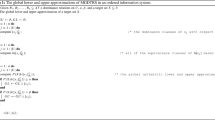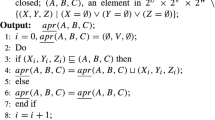Abstract
Numerous studies have extensively examined the correlation between convex structures and covering rough set models. However, limited attention has been devoted to investigating the relationship between convex structures and rough set models based on relations. In this paper, we aim to integrate convex geometry with rough sets based on relations. Firstly, a novel class of binary relation known as quasi-atomic relation is introduced. We show that each ordinal convex geometry can be reformulated by rough sets based on quasi-atomic relations. Subsequently, we illustrate that any convex geometry can be embedded in an ordinal convex geometry using the rough set approach. Secondly, we develop a new model called the multi-valued rough set model which serves as a valuable tool for investigating convex geometry. A novel representation of any convex geometry is provided by multi-valued rough sets based on the family of quasi-atomic relations. Furthermore, we demonstrate that any convex geometry can be decomposed into a union of ordinal convex geometries. Lastly, We develop a method to determine whether an element belongs to a convex closure of a given set. In addition, we incorporate terminologies from rough set theory into the study of convex geometry by defining concepts such as rough convex sets and degree of convexity which are utilized to analyze the structure of convex geometry. In summary, this paper offers an efficient method to integrate rough sets with convex geometry, which extends the theory and application of rough sets.



Similar content being viewed by others
Data Availability
Data sharing is not applicable to this article as no datasets were generated during the current study.
References
Alcantud J, Zhan J (2022) Convex rough sets on finite domains. Inform Sci 611:81–94
Edelman P, Jamison R (1985) The theory of convex geometries. Geometriae Dedicata 19(3):247–270
Gégény D, Kovács L, Radeleczki S (2022) Lattices defined by multigranular rough sets. Int J Approximate Reason 151:413–429
Koshevoy G (1999) Choice functions and abstract convex geometries. Math Soc Sci 38(1):35–44
Kashiwabara K, Okamoto Y (2003) A greedy algorithm for convex geometries. Discrete Appl Math 131:449–465
Li X, Yi H, Liu S (2016) Rough sets and matroids from a lattice-theoretic viewpoint. Inform Sci 342:37–52
Long Z, Cai M, Li Q, Li Y, Cai W (2023) Convex granules and convex covering rough sets. Eng Appl Artif Intell 124:106509
Pawlak Z (1982) Rough sets. Int J Computer Inform Sci 11:341–356
Pawlak Z, Skowron A (2007) Rudiments of rough sets. Inform Sci 177:3–27
Pei Z, Pei D, Zheng L (2011) Topology vs generalized rough sets. Int J Approximate Reason 52:231–239
Qian Y, Liang J (2006) Rough set method based on multi-granulations. In: Proceedings of the 5th IEEE Conference on Cognitive Informatics, 1 pp. 297–304
Qian Y, Liang J, Dang C (2010) Incomplete multigranulation rough set. IEEE Transactions on Systems, Man, and Cybernetics Part B 20:420–431
Richter M, Rubinstein A (2015) Back to fundamentals: Equilibrium in abstract economies. American Econ Rev 105(8):2570–2594
She Y, He X (2012) On the structure of the multigranulation rough set model. Knowledge-Based Syst 36:81–92
Wang Z, Feng Q, Wang H (2019) The lattice and matroid representations of definable sets in generalized rough sets based on relations. Inform Sci 485:505–520
Wang Z, Wang H, Feng Q, Shu L (2015) The approximation number function and the characterization of covering approximation space. Inform Sci 305:196–207
Wang S, Zhu Q, Zhu W, Min F (2013) Quantitative analysis for covering-based rough sets through the upper approximation number. Inform Sci 220:483–491
Wu H, Liu G (2020) The relationships between topologies andgeneralized rough sets. Int J Approximate Reason 119:313–324
Yao Y (1998) Constructive and algebraic methods of theory of rough sets. Inform Sci 109:21–47
Yao Y (1998) Relational interpretations of neighborhood operators and rough set approximation operators. Inform Sci 111:239–259
Yao Y, Zhang X (2017) Class-specific attribute reducts in rough set theory. Inform Sci 418–419:601–618
Yao Y, She Y (2016) Rough set models in multigranulation spaces. Inform Sci 327:40–56
Yao W, Han S (2023) A topological approach to rough sets from a granular computing perspective. Inform Sci 627:238–250
Zhang X, Miao D, Liu C, Le M (2016) Constructive methods of rough approximation operators and multigranulation rough sets. Knowl-Based Syst 91:114–125
Zhang X, Yao H, Lv Z, Miao D (2021) Class-specific information measures and attribute reducts for hierarchy and systematicness. Inform Sci 563:196–225
Zhao Z (2016) On some types of covering rough sets from topological points of view. Int J Approximate Reason 68:1–14
Zhao F, Pang B, Mi J (2022) A new approach to generalized neighborhood system-based rough sets via convex structures and convex matroids. Inform Sci 612:1187–1205
Zhu W (2007) Topological approaches to covering rough sets. Inform Sci 177:1499–1508
Zhu W (2009) Relationship between generalized rough sets based on binary relation and covering. Inform Sci 179:210–225
Acknowledgements
This work is supported by the Natural Science Foundation of Shanxi Province, China (No. 202103021224261).
Author information
Authors and Affiliations
Contributions
Zhaohao Wang: Conceptualization, Methodology, Formal analysis, Software, Visualization.
Corresponding author
Ethics declarations
Competing Interests
The authors declare that they have no known competing financial interests or personal relationships that could have appeared to influence the work reported in this paper.
Additional information
Publisher's Note
Springer Nature remains neutral with regard to jurisdictional claims in published maps and institutional affiliations.
Rights and permissions
Springer Nature or its licensor (e.g. a society or other partner) holds exclusive rights to this article under a publishing agreement with the author(s) or other rightsholder(s); author self-archiving of the accepted manuscript version of this article is solely governed by the terms of such publishing agreement and applicable law.
About this article
Cite this article
Wang, Z. Quasi-atomic relations based rough set model and convex geometry. Appl Intell 54, 4230–4247 (2024). https://doi.org/10.1007/s10489-024-05405-1
Accepted:
Published:
Issue Date:
DOI: https://doi.org/10.1007/s10489-024-05405-1




